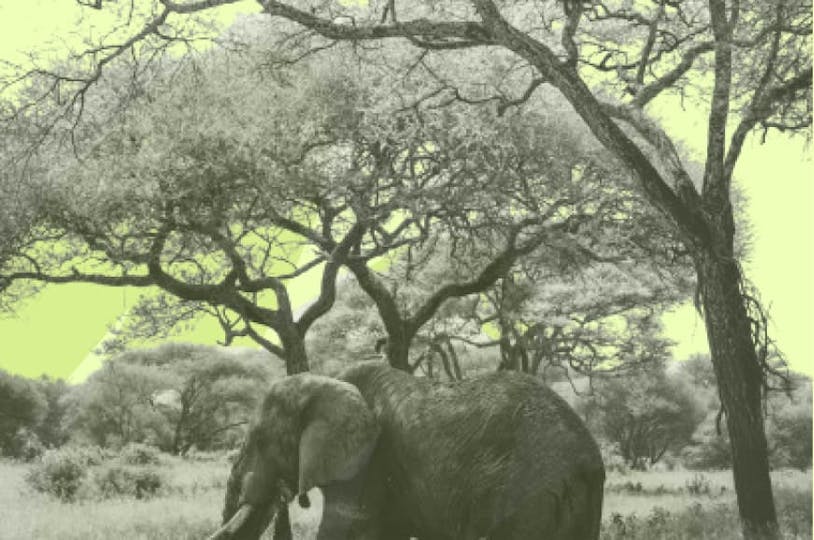
Sustainable Development Goals (SDGs): All You Need to Know
The United Nations has defined 17 goals, aimed at creating a better world. What are these so-called "Sustainable Development Goals" ? Explanations.
ESG / CSR
Industries
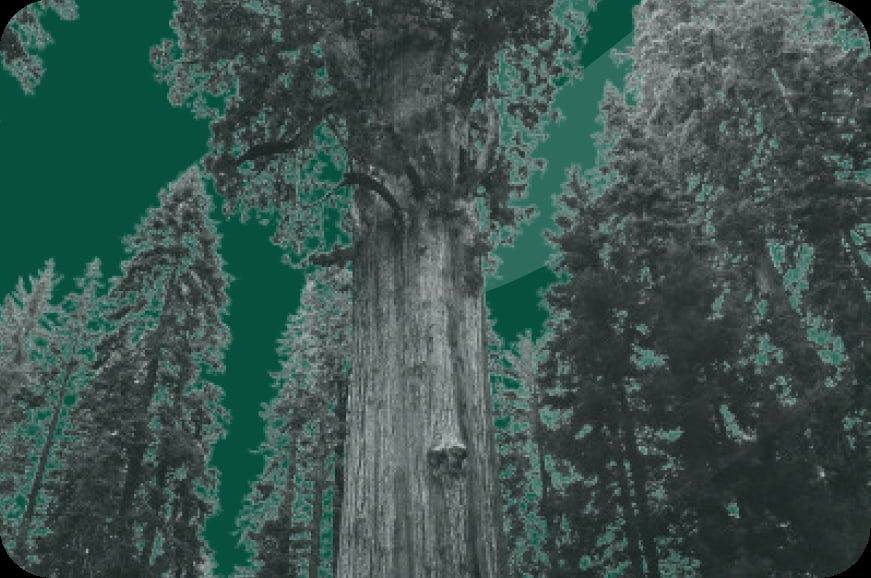


The Giant Sequoia is one of the natural world's most compelling trees. Native to the Sierra Nevada mountain range in California, these Giant Sequoias are towering trees that can live to be over 3,000 years old. Their massive height, width, and lifespan make these trees fascinating, drawing interest from scientists, ecologists, and tourists who visit National Parks to experience these trees up close and personal .
However, recent research, as shared by the Save the Redwoods League – highlights how climate change is threatening their survival. From increasingly severe droughts and more frequent, intense wildfires to declining regeneration rates, a number of factors are holding Giant Sequoias back from thriving. Let's learn more about the significance of these amazing trees and how we can help ensure their survival for generations to come.
In this article, we'll learn about the Giant Sequoia's ecological significance, unpack the challenges these trees face as a result of climate change, and discover conservation efforts in progress to help the Giant Sequoia continue to thrive in the Sierra Nevadas.


The Giant Sequoia is among the oldest and largest living plants on Earth. They can reach a height of over 300 feet (91 meters) and have diameters exceeding 30 feet (9 meters) at their bases, weighing over 600 tonnes.
The Giant Sequoia, characterized by its vast heights and thick protective bark, can live 3,000 years. Located in the Sierra Nevada Mountains, these are among the oldest living plants on the planet and can help us fight climate change by absorbing large amounts of CO₂.
While the Giant Sequoia stands tall at a whopping 250 to 280 feet in height, it's actually not the tallest tree species in the world – the title of the "world's largest tree" belongs to its coastal cousin, the coast redwood, which can reach heights exceeding 380 feet.
However, it is important to note that while Giant Sequoias may be lacking in staggering height in comparison to their Redwood cousins – pure height, Giant Sequoias more than make up for in sheer volume and mass.
The famous General Sherman tree, located in Sequoia National Park, holds the record as the largest living tree by total volume, whereas the General Grant tree in Kings Canyon National Park is known as the "Nation's Christmas Tree" – as its age and size are reminiscent of the holidays.
Did you know? The General Sherman tree is the largest known living single stem tree and is estimated to weigh a whopping 6,147 tons!
These sierra redwood giants, thriving on the western slopes of the Sierra Nevada mountains, play a vital role in forest ecology by creating unique canopy environments that support diverse wildlife communities.
Interestingly, immature trees can grow rapidly in their early decades, sometimes growing several inches in both width or height each year – but their growth notably slows down as they mature, reallocating their energy on developing their characteristic massive trunk diameter as opposed to growing in height. This growth pattern helps explain why these ancient giants have been able to survive for millennia in their mountainous ecosystem.
Furthermore, recent studies such as from Advancing Earth Sciences reveal that climate change may actually be allowing these already tall-standing trees to experience a late growth spurt.
The drop down sections below will share information on the three tallest trees in the world:
The Hyperion is a coastal redwood discovered in 2006 in a remote area of Redwood National Park, California. It holds the title of the tallest tree in the world, standing at a staggering 115.92 meters (380.3 feet).
Menara is the tallest known tropical tree, located in the Danum Valley Conservation Area in Sabah, Malaysian Borneo. It reaches a height of 100.8 meters (331 feet), making it the tallest flowering plant on Earth.
The Tualang tree is native to Southeast Asia and often grows in lowland rainforests. It is one of the tallest tropical trees globally, reaching heights up to 88.3 meters (290 feet). Its broad crown and smooth bark make it easily distinguishable.
The lifespan of these trees is almost hard to fathom, with some individual trees over 3,000 years old, making them true ancient giants. The oldest living Giant Sequoia, tagged CBR26 by researchers, is approximately 3,266 years old!
The long lifespans of these trees are a result of their thick, fire-resistant bark and robust root systems that enable them to withstand various natural disturbances, including wildfires and droughts.
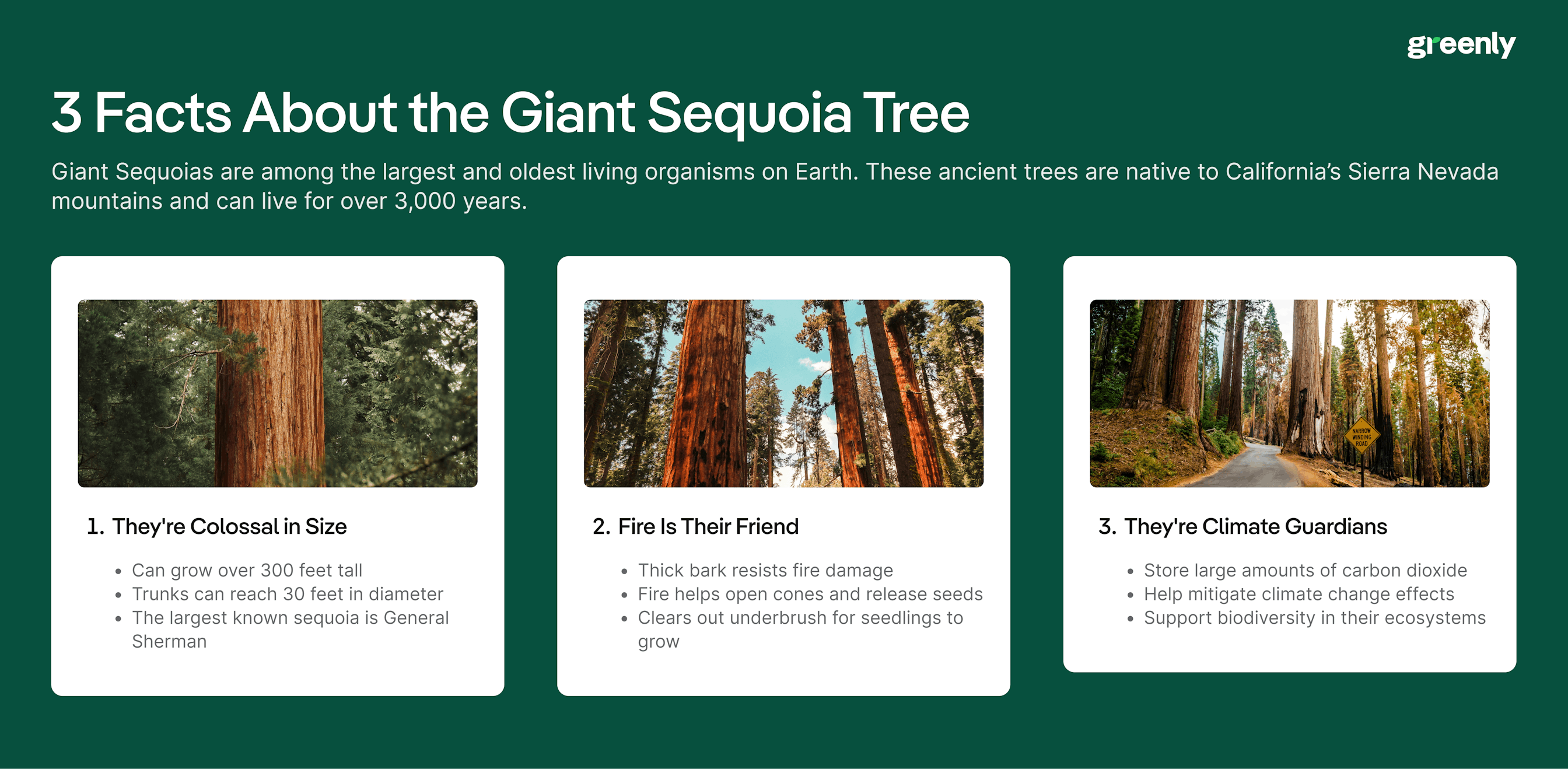

Studies highlight the Giant Sequoia's unique reproductive system and how Giant Sequoia regeneration works. Believe it or not, nowhere does a Giant Sequoia grow without a wildfire – as the cones containing Giant Sequoia seeds remain closed for up to 20 years, only opening to release seedlings when exposed to the heat of wildfires.
This fascinating adaptation actually helps spread sequoia seedlings and allow new trees to grow, as seeds are released into nutrient-rich ash beds following the fire. If no periodic wildfires were to occur, shade-loving species would overshadow young sequoia seedlings, and sequoia seeds would not germinate.
The timeline below will depict how giant sequoia seedlings are formed into a young tree, into large trees, and ultimately into a parent tree.
Giant Sequoias grow and thrive in the moist, well-drained soil found in the Sierra Nevada Mountains. They require a specific combination of elevation, climate, and soil conditions, typically found between 4,000 and 8,000 feet (1,200 to 2,400 meters) above sea level.
These trees play a critical role in the forest ecosystem, providing both habitat and food for wildlife species like woodpeckers, squirrels, and black bears. Additionally, due to their long lifespans and massive heights and widths, Giant Sequoia trees act as carbon sinks, absorbing and storing significant levels of CO2 that can help mitigate the impacts of climate change.
In fact, according to The Planet’s Lungs: Planting Giant Sequoias to Combat Carbon Dioxide, a single Giant Sequoia is estimated to be able to store up to 1,000 tons of carbon – demonstrating the remarkable, positive environmental impact that a Giant Sequoia ecosystem can provide to our struggling planet.
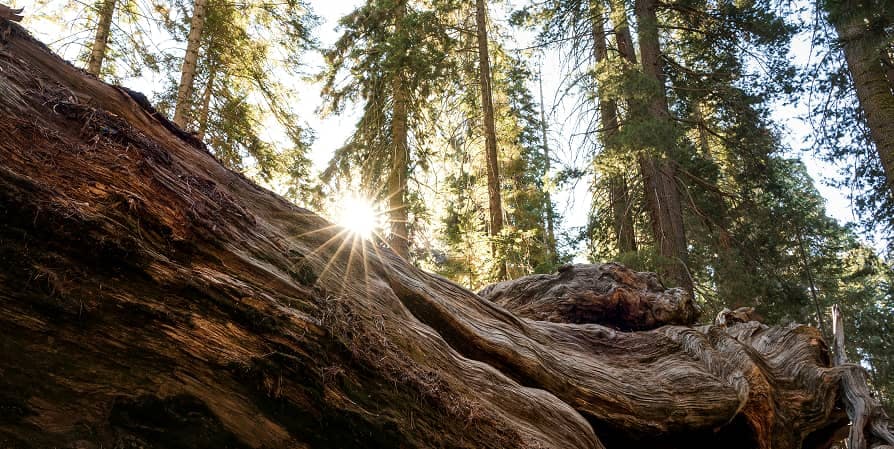
Did you know that the Giant Sequoia helped establish the National Parks system in the United States?
Although now home to over 1 million visitors every year, the Sequoia National Park not only serves as a calming retreat and easily accessible road trip for people living in California and Nevada – but as a safe haven for sequoia trees.
Additional parks and areas where Giant Sequoia trees are protected include:
Established in 1890, the Sequoia National Park was created specifically to protect Giant Sequoia groves from human threats like logging – which involves cutting trees for to be sold for commercial use.
Logging was a significant threat to the Giant Sequoia, as about one third of the ancient trees in the area had already been cut down as part of logging practices by 1800.
Logging is used for numerous purposes in everyday consumerism. The flip cards below will explain how logging is used to build homes, for everyday paper, furniture, and additional paper-based products:
This was only the second National Park established in the U.S. and the first formed with the primary goal of protecting a living organism. This significant shift in conservation efforts created a domino effect, with additional National Parks established quickly thereafter, namely the General Grant National Park (now Kings Canyon National Park) aimed to protect Giant Sequoia groves.
Interest in the Giant Sequoia helped drive interest in preserving stretches of the American wilderness. Protecting these giant trees from logging led to establishing some of the first National Parks in the United States.
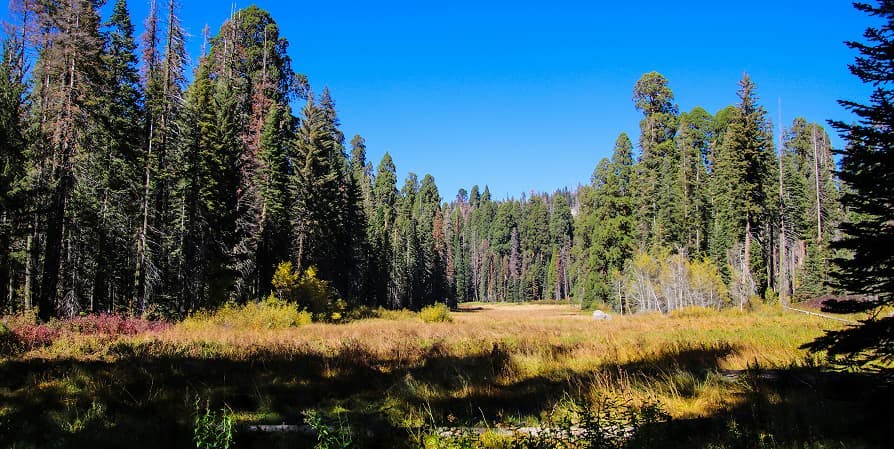
Climate change poses one of the most significant threats to giant sequoias. Rising temperatures cause droughts and wildfires, while human activity such as road construction and tourism can impact the complex root systems of the Giant Sequoia.
As we hurdle in 2025 with continuous prolonged droughts, heatwaves, and barren lands such as with the most recent Los Angeles wildfires – the prosperity of sequoia trees has never been more prominent than it is now.
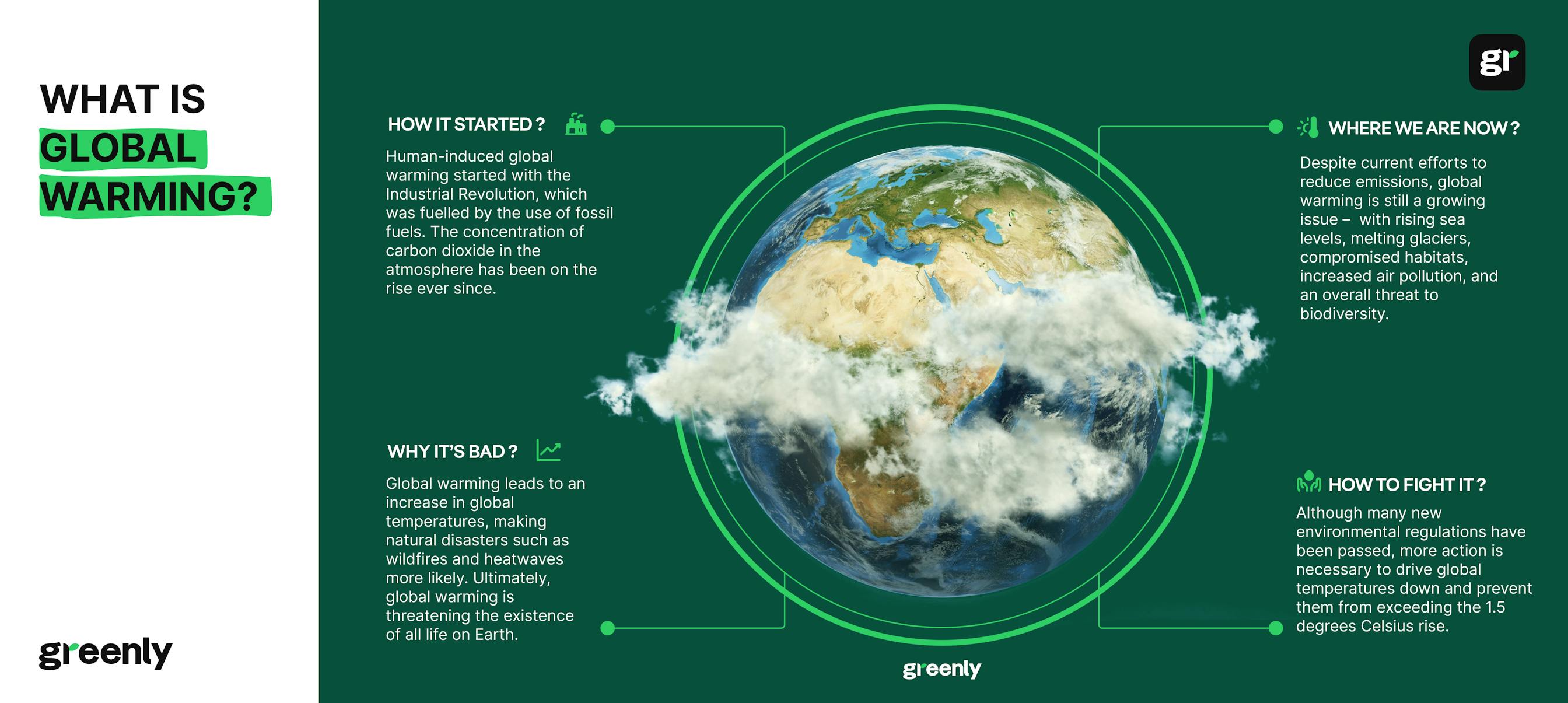

Here's a more detailed breakdown on how climate change has and will continue to impact sequoia trees:
Severe droughts, like California’s 2012-2016 drought, impact the Giant Sequoia by exerting extreme stress. This appears as foliage dieback (where the trees shed leaves until their crowns are significantly thinner) on a physiological level.
Droughts also impact soil moisture as the upper layers of soil become increasingly arid and even with deep root systems, the trees struggle to find water sources. Drought conditions also make the Giant Sequoia vulnerable to beetle infestations and damages from wildfires.
However, it is important to note that the impact a drought can have on Giant Sequoias depends on its location. Slope elevation, water proximity, and the depth of the tree’s root are all significant factors as to whether an individual tree will survive in extreme drought conditions.
Though wildfires are a natural element of the forest ecosystem, they have become more frequent and intense due to climate change – as we have seen in recent years with the Hawaii and Los Angeles wildfires.
Wildfires can be positive in the sense that they clear the forest floor, open up sequoia cones to release seeds into the nutrient-rich ash bed left behind, and increase the amount of sunlight hitting the forest floor. However, the extreme heat from modern wildfires can damage even the thick bark of mature sequoias, leading to increased mortality rates.
For instance, the 2020 Castle Fire esulted in the loss of an estimated 10-14% of the world's mature giant sequoias, while the KNP Complex Fire in 2021 saw mature trees dying – as cones were unable to successfully release seedlings due to the extreme heat.
Tourism, urban development, and logging are all human activities that threaten the Giant Sequoia’s ability to thrive. While logging has been curbed due to legal protections, fire suppression has led to an accumulation of ladder fuels that ultimately increase the intensity of severe wildfires that can destroy Giant Sequoia groves.
Additionally road construction and urban development can negatively impact their root systems. Giant Sequoia roots can extend over a hundred feet from a tree’s base, making them vulnerable to damage from pedestrians and vehicles that ultimately handicap their nutrient absorption.
Ultimately, climate change presents challenges to the survival of the Giant Sequoia, namely intense droughts, wildfires, and even human activity plaguing the region.
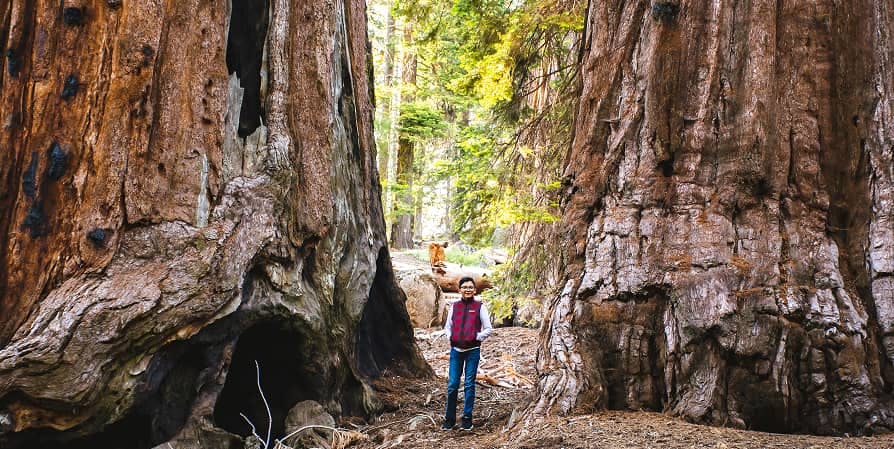
There are many ways we can help to save sequoias across the country, such as by promoting the importance of ecotourism and conservation efforts to ensure the national parks protecting the sequoia trees remain hospitable.
Ecotourism, when managed sustainably, can provide economic incentives for local communities to protect giant sequoias and their habitats. Visiting the Giant Sequoia groves remains as a popular tourist attraction, allowing visitors to learn more about these amazing trees and witness them up close.
However, while these tourist destinations can be beneficial for raising awareness, tourism can also pose risks if not managed sustainably. Heavy visitation and repeated walking by visitors can compact soil around sequoia roots, reducing their ability to absorb water and nutrients.
The drop down sections below will share some ideas to promote ecotourism in National Parks where sequoias, green cones, and other competing vegetation live:
Organize interpretive walking tours led by local conservationists to educate visitors on the ecological role of sequoias, green cones, and old-growth biodiversity.
Reduce foot traffic and vehicle emissions by promoting electric shuttle use and limiting daily park entries to protect fragile forest ecosystems.
Install signs at scenic areas that explain what makes the ecosystem unique—such as the importance of cone-bearing species or inter-species competition.
Offer travelers a chance to give back by planting native species or removing invasive plants that threaten sequoia saplings and understory diversity.
Conservation efforts unite National Parks representatives and researchers to learn more about the Giant Sequoia and protect this species for the future.
Key initiatives include:
The Save the Redwoods League works to manage wildfires through controlled burns and removing debris to reduce the fuel loads that lead to damaging fires. Additionally, mechanical thinning reduces competition for water and measures to improve air quality help to preserve the health of these groves.
Initiatives like the Sequoia Parks Conservancy work to conserve the groves by actively replanting seedlings, preserving wildlife within the National Parks, and maintaining 866 miles (1,394 kilometers) of hiking trails that allow visitors to responsibly engage with the Giant Sequoia groves.
Conservancy groups also work to reduce the impact of invasive species like foxglove, Spanish broom, and Italian thistle, as well as mitigating the effects of bark beetle attacks.
Overall, the Giant Sequoia is an example of how nature can do its best work when uninterrupted – but it's important for us has humans to ensure that these powerful trees are protected from the harmful effects of climate change.
The Giant Sequoia holds an important place in our understanding of the natural world. With its long life span and astonishing size, these trees also work to fight climate change by absorbing and storing significant amounts of CO₂.
While it's true that tress such as the Giant Sequoia can help to absorb excess carbon, it is important for all of us to look for ways to offset or cut emissions. If you're wondering what your company can do to contribute, and aren't sure where to start – look no further than Greenly.
At Greenly, we work with businesses to identify and lower their carbon footprint. Combining human analysis and innovative technology, Greenly creates personalized carbon accounting that is accessible to a wide range of companies no matter their size.
Request a free demo with a member of our expert team to learn more about how to get started on your journey to help fight climate change.
